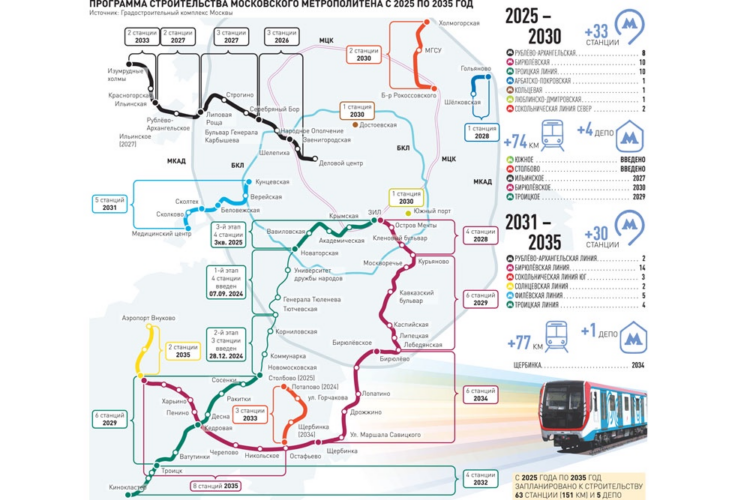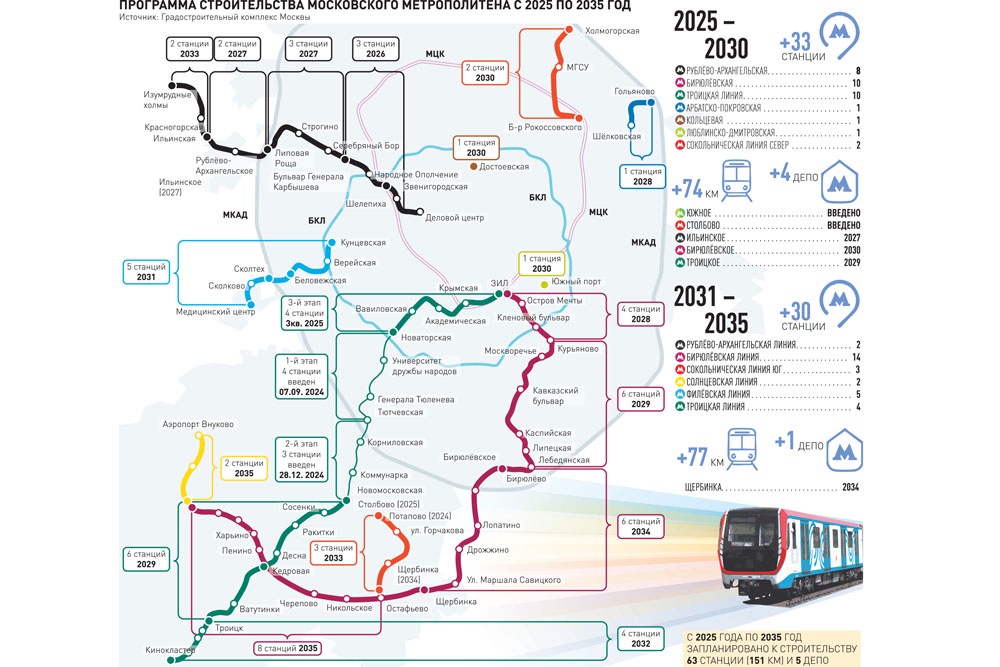63 underground stations to be built in Moscow in 10 years
Published: by .

Where are we going?
You can study the program using our infographics – it is easy to understand from it that, for example, out of 33 stations planned for commissioning by 2030, 28 are located on three lines. It is on them that the main efforts of metro builders are currently concentrated.
For example, the Rublevo-Arkhangelskaya line will stretch from the Moscow-City business complex to the business district currently under construction beyond the Moscow Ring Road and further into the Moscow region. According to plans, in 2033 the line may reach Krasnogorsk in the Moscow region and the Izumrudnye Kholmy microdistrict. The line will also play an important role within the Moscow Ring Road. In total, it should improve transport services for more than 800 thousand Muscovites living in Mitino, Strogino, Khoroshevo-Mnevniki and other areas of the city.
The line will be marked on the diagrams in graphite color – it was chosen by Muscovites themselves during the voting on "Active Citizen". At the same time, the Troitskaya line was given emerald color, and the Biryulevskaya line – ruby.
By the way, about Biryulevskaya. The need to build an underground railway in Western and Eastern Biryulyovo was discussed back in Soviet times, but the projects changed, construction was postponed, and thousands of people continued to live as if in transport captivity. For example, Biryulyovo Western is a kind of triangle on the map formed by the Moscow Ring Road and two railway lines. They seem to take the area in a vice, and getting out of it is not an easy task. The underground railway should solve this problem.
In the coming years, the first 10 stations will open on the Biryulevskaya line. Residents of the Danilovsky, Nagatinsky Zaton, Pechatniki, Moskvorechye-Saburovo, Tsaritsyno, Biryulyovo Vostochnoye and Biryulyovo Zapadnoye districts with a population of over 600 thousand people will receive fast and reliable transport. And then the line can extend to Shcherbinka and other settlements of New Moscow.
In the coming years, the first 10 stations will open on the Biryulevskaya line. Residents of seven districts of the capital will receive fast and reliable transport
Finally, the last of the three new lines is Troitskaya. It will run from the ZIL station on the territory of the former auto giant, where a new residential area is currently growing, to New Moscow, namely the city of Troitsk. The launch of the line will improve the transport situation in the southwest and south of the capital, and will also make life easier for those living in TiNAO. For example, more than 65 thousand people live in Troitsk, and the city does not have a subway or a railway – you can get to "old" Moscow only via the Kaluga Highway.
From Golyanovo to Dostoevskaya
But, of course, in addition to new lines, stations will also appear on existing radii. For example, on the Arbatsko-Pokrovskaya line, they have already begun building the Golyanovo station – it will become the new terminus after Shchelkovskaya. The station will appear in the center of the district – at the intersection of Ussuriyskaya and Sakhalinskaya streets. "The metro will become closer for 230 thousand Muscovites. Many will be able to get there on foot," – the mayor of the capital, Sergei Sobyanin, described the effect of the station's appearance. – Shchelkovskoye Highway and the Shchelkovskaya station will be relieved. Travel time on public transport will be reduced by at least 15-20 minutes."
A new station will even appear in the city center. We are talking about "Dostoyevskaya", which is currently being built on the Circle Line near the Russian Army Theater. This station was planned back in the 1950s, and a reserve was left for it. In the 1990s, a place was even laid for a construction site, but this attempt was also unsuccessful. Technically, the task is very difficult – it is necessary to build a new station on an existing line, where trains with passengers constantly travel.

Comments